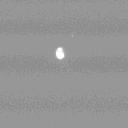Pallene (księżyc)
 Zdjęcie z sondy Cassini, wykonane we wrześniu 2010 r. | |
| Planeta | |
|---|---|
| Odkrywca | Cassini Imaging Team |
| Data odkrycia | 1 czerwca 2004 |
| Tymczasowe oznaczenie | S/2004 S 2 |
| Charakterystyka orbity | |
| Półoś wielka | 212 282 km[1] |
| Mimośród | 0,0040[1] |
| Okres obiegu | 1,154 d[1] |
| Nachylenie do płaszczyzny Laplace’a | 0,001°[1] |
| Długość węzła wstępującego | 123,180°[1] |
| Argument perycentrum | 16,074°[1] |
| Anomalia średnia | 356,229°[1] |
| Własności fizyczne | |
| Średnica równikowa | 5 ± 1,2 km[2] |
| Wymiary | 5,8 × 5,6 × 4,0 km[2] |
| Okres obrotu wokół własnej osi | synchroniczny |
| Jasność obserwowana (z Ziemi) | 25m |
Pallene (Saturn XXXIII) – księżyc Saturna, odkryty wraz z Methone na zdjęciach przesłanych przez sondę Cassini latem 2004 roku.
Pallene została pierwszy raz uwieczniona jeszcze przez sondę Voyager 2, na pojedynczym zdjęciu zrobionym 23 sierpnia 1981 roku i oznaczona tymczasowo S/1981 S 14. Jedno zdjęcie pozwalało jednak tylko oszacować promień orbity księżyca i dopiero obserwacje sondy Cassini pozwoliły odnaleźć ten obiekt.
Nazwa pochodzi od Pallene – jednej z Alkyonid (7 córek Alkyoneusa).
Zobacz też
- chronologiczny wykaz odkryć planet, planet karłowatych i ich księżyców w Układzie Słonecznym
- księżyce Saturna
Przypisy
- ↑ a b c d e f g Planetary Satellite Mean Orbital Parameters. Jet Propulsion Laboratory, 2011-12-14. [dostęp 2012-08-05]. (ang.).
- ↑ a b P.C. Thomas. Sizes, shapes, and derived properties of the saturnian satellites after the Cassini nominal mission. „Icarus”. 208 (1), s. 395-401, lipiec 2010. DOI: 10.1016/j.icarus.2010.01.025. (ang.).
Linki zewnętrzne
- Pallene. [w:] Księżyce Układu Słonecznego [on-line]. [dostęp 2016-02-06]. [zarchiwizowane z tego adresu (2014-07-14)].
- Pallene. [w:] Solar System Exploration [on-line]. NASA. [dostęp 2018-12-26]. (ang.).
- AstroNEWS: Cassini odkrywa księżyce. news.astronet.pl. [zarchiwizowane z tego adresu (2014-07-14)]. (pol.)
Media użyte na tej stronie
This is a revised version of Solar_System_XXIX.png.
Saturn Cassini-Huygens (NASA)
Instrument: Imaging Science Subsystem - Narrow Angle
Saturn's peaceful beauty invites the Cassini spacecraft for a closer look in this natural color view, taken during the spacecraft's approach to the planet. By this point in the approach sequence, Saturn was large enough that two narrow angle camera images were required to capture an end-to-end view of the planet, its delicate rings and several of its icy moons. The composite is made entire from these two images.
Moons visible in this mosaic: Epimetheus (116 kilometers, 72 miles across), Pandora (84 kilometers, 52 miles across) and Mimas (398 kilometers, 247 miles across) at left of Saturn; Prometheus (102 kilometers, 63 miles across), Janus (181 kilometers, 113 miles across) and Enceladus (499 kilometers, 310 miles across) at right of Saturn.
The images were taken on May 7, 2004 from a distance of 28.2 million kilometers (17.6 million miles) from Saturn. The image scale is 169 kilometers (105 miles) per pixel. Moons in the image have been brightened for visibility.
The Cassini-Huygens mission is a cooperative project of NASA, the European Space Agency and the Italian Space Agency. The Jet Propulsion Laboratory, a division of the California Institute of Technology in Pasadena, manages the Cassini-Huygens mission for NASA's Office of Space Science, Washington, D.C. The Cassini orbiter and its two onboard cameras, were designed, developed and assembled at JPL. The imaging team is based at the Space Science Institute, Boulder, Colo.
For more information, about the Cassini-Huygens mission visit, http://saturn.jpl.nasa.gov and the Cassini imaging team home page, http://ciclops.org.N00163156.jpg was taken on September 13, 2010 and received on Earth September 15, 2010. The camera was pointing toward PALLENE, and the image was taken using the CL1 and CL2 filters. This image has not been validated or calibrated. A validated/calibrated image will be archived with the NASA Planetary Data System in 2011
Discovery image of Pallene (S/2004 S 2), a satellite of Saturn. Image taken by the en:Cassini-Huygens probe on June 1, 2004 from 16 Gm. This image has been cropped down from the original.




